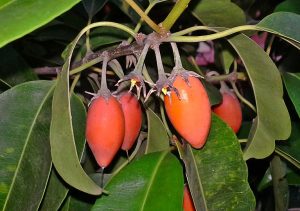BOTANICAL NAME: Mimusops elengi
FAMILY: Sapotaceae
CLASSICAL CLASSIFICATION:
Bhavaprakasha Nighantu Pushpa varga
ENGLISH NAME: Spanish cherry, Medlar, Bullet wood
COMMON NAME:
Hindi: Moulasiri
Bengali: Bakul
Kannada: Bakulada hoovugalu


REFERENCE: BHAVAPRAKASH SAMHITA with link e Nighantu:
https://niimh.nic.in/ebooks/e-Nighantu/bhavaprakashanighantu/?mod=read
बकुलो मधुगन्धश्च सिंहकेसरकस्तथा |
बकुलस्तुवरोऽनुष्णः कटुपाकरसो गुरुः |
कफपित्तविषश्वित्रकृमिदन्तगदापहः ||२६||
HABITAT: It is a medium-sized evergreen tree.
BOTANICAL DESCRIPTION: It is a large tree growing to a height of 12-15 m and is found all over India. The central wood of the tree is hard with reddish color. The flowers are pale yellow or white with a pleasant smell. The fruit is found with 1-2 shining seeds within.
AYURVEDIC CHARACTERISTICS:
| RASA | GUNA | VEERYA | VIPAKA | PRABHAVA | DOSHGHNTA |
| Katu, Kaşaya | Guru | Cold | Katu | – | Pittakapha shamaka |
AYURVEDIC ENERGETICS:
| TASTE | PROPERTY | POTENCY | POST DIGESTIVE EFFECT | EFFECT ACTION | DOSHA ACTION |
| Pungent
Bitter astringent |
Light
Dry Sharp |
Hot | Pungent | – | Pacifying Pitta and Kapha dosha |
MAJOR CHEMICAL CONSTITUENTS: Plant contains D-Mannitol, beta sitosterol and D glycoside. pentacyclic triterpene acids and mimusopic acid.
THERAPEUTIC USES:
- Headache and sinusitis- The powder of the dried flowers or the juice of fresh flowers of Bakula is administered through the nostrils.
- Gingivitis- The decoction prepared from the bark of the tree of Mimusops elengi is used for gargling to treat diseases of the oral cavity
- Diarrhea and intestinal worms– The cold infusion or decoction prepared from the bark of the stem is given in a dose of 40-50 ml
- General tonic- The cold infusion or decoction of the flowers of bakul
INDICATIONS:
Visha Toxic conditions, poisoning, Shvitra Leucoderma, Krumi Worm infestation, Dantaroga Tooth decay
USEFUL PART: Bark, Flower and Fruit
DOSAGE: Decoction of bark- 50 to 60 ml Powder of flower- 1 to 2 gm
AYURVEDIC FORMULATION:
1. Baladhatryadi taila
